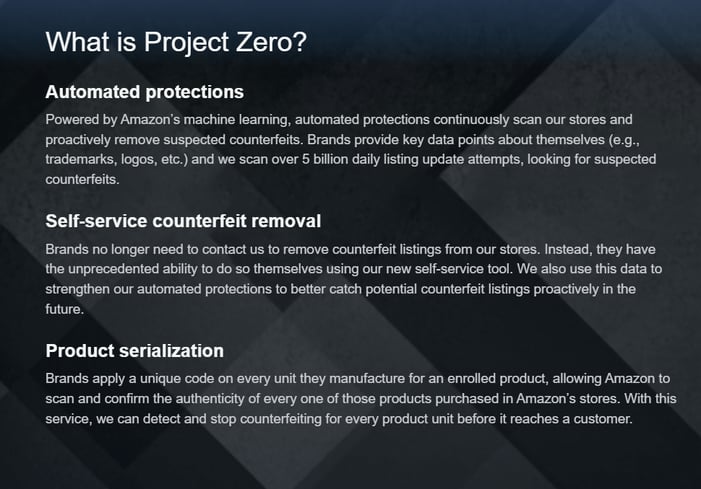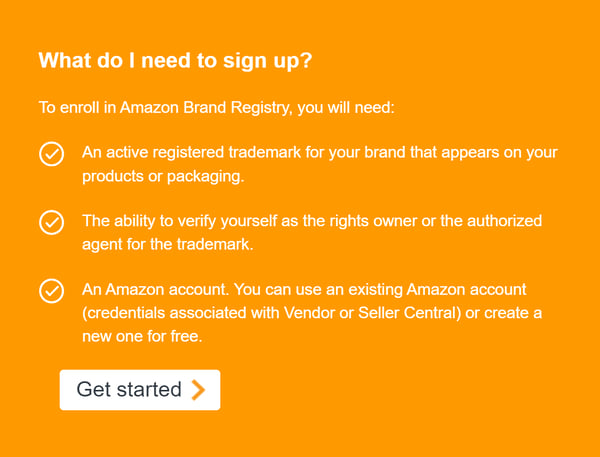✍ This article was written by Bobsled Marketing Manager Tom Crosthwaite
with contributions from Bobsled Project Manager Armin Alispahic.
Many brands have been contending with counterfeiters on the Amazon platform for a long time, and traditionally there’s been limited ways for trademark owners to protect listed products from offending parties.
But there’s a change in the air. A recent Washington Post article explained how the plethora of counterfeit products was negatively impacting consumer trust, and that Amazon spent $400 million in a single calendar year fighting fraud and terms of service violations.
One of the new tools is Project Zero, a Brand Registry program, which enables brands to deal with counterfeiting through a self-serve tool and also enrolls them in automated counterfeit protection based on Amazon’s machine learning. In addition, brands can take part in product serialization by applying a unique barcode to every product destined to go live on Amazon, making spotting and removing fakes quick and easy.
In this article we’re going to break down how Project Zero works, the main advantages, and how the program (and Brand Registry in general) could potentially help you fight your counterfeiter problem on Amazon.

What Is Project Zero?
Above: Screenshot from brandservices.amazon.com
To gain access to Project Zero, eligible brands will deliver some key brand protection data points (see below). A key benefit of Project Zero is product serialization, a feature that is optional for program participants. Should brands enrolled in Project Zero opt in, Amazon will provide members with unique barcodes for each product. This code is scanned by the Amazon fulfillment team as they receive and process the inventory, thereby stopping potential counterfeit products before they even "hit the shelves" and become eligible for customer purchase.
Amazon continuously scans its stores and proactively removes suspected counterfeits before customers have a chance to buy the product. Both Vendors and Sellers can apply for the program.
Importantly, there is also a self-service component. Rather than having to contact Amazon after a counterfeit listing has been identified, Project Zero members can remove the listing from their stores themselves.
Above: Screenshot from brandservices.amazon.com
Project Zero Eligibility
Project Zero is an extension of the Brand Registry program. The eligibility requirements are as follows:
-
Your brand must be enrolled in Amazon Brand Registry with a government-registered trademark.
-
You must:
- Be the rights owner of the trademark.
- Have an Amazon account with access to Brand Registry.
- Have submitted reports of potential infringements with an acceptance rate of at least 90% in the last six months.
Note: at the time of publication, Project Zero is currently an invite-only program, but you can visit the website to join the waitlist.
A Little More About Brand Registry
If you’re unaware, there are a couple of core benefits, from a brand protection perspective, to going through the brand registry process.
Above: Screenshot from brandservices.amazon.com
- Accurate Brand Representation. Simply put, registered brands have greater control over content on product pages. For example, if you have resellers, and they are messing with your listing content, brand registry will “lock” the listing with the correct content. Other parties can still compete for the Buy Box, but only the trademark owner can manipulate the listing content.
- Powerful Search Tools. The brand registry search function will save you time when it comes to identifying counterfeit products. You can search for ASINs or even specific images, making it straightforward to find knock-off versions of your products globally. Without brand registry, this process is tedious and extremely time-consuming.
When a violation occurs, you simply submit a report via the Brand Registry dashboard, and Support will investigate.
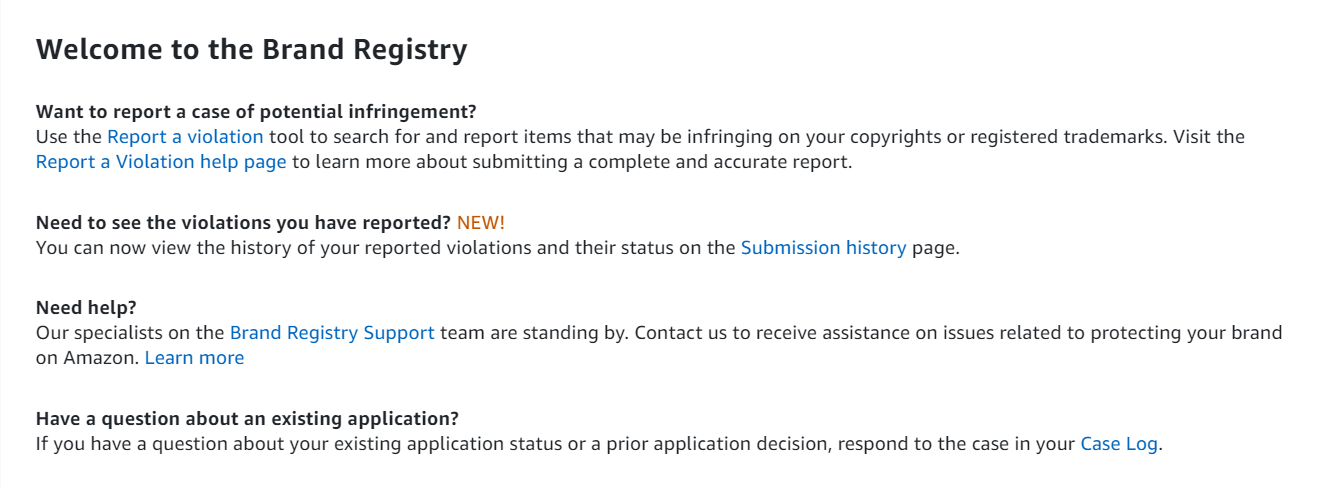
Above: Screenshot from brandregistry.amazon.com
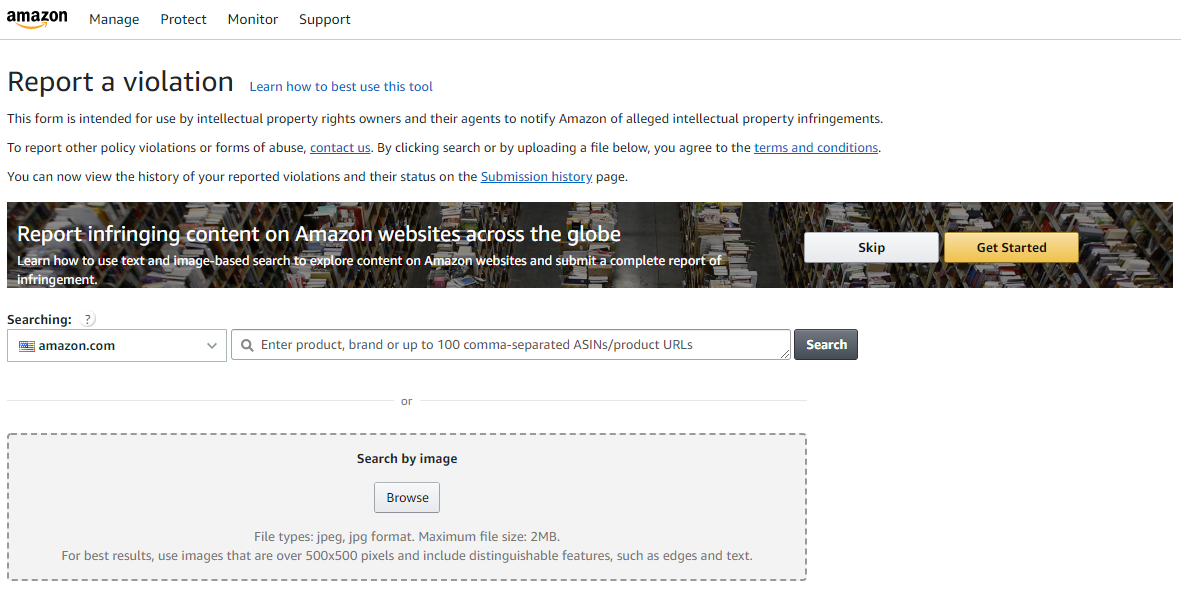
Above: Screenshot from brandregistry.amazon.com
As parties currently dealing with brand protection headaches will attest, the best time to enrol in brand registry is before any violations occur! Also, becoming brand registered and submitting reports of potential infringements with an acceptance rate of at least 90% in the last six months is a prerequisite for Project Zero. So for most brands getting brand registered asap is a no-brainer.
Here’s the link to start the process.
Above: Screenshot from brandservices.amazon.com
Brand Protection Tips & Best Practices
So what’s the secret sauce when it comes to excellent brand protection metrics? Of course, ongoing tasks will vary for every Vendor and Seller, but there are certain measures that apply across the board.
1. Ensure your listings are tied to brand registry
If you go to the effort of setting up brand registry, the final step is to ensure all of your listings are actually being protected. The easiest way to check whether an ASIN is tied to brand registry in Seller Central is to check its eligibility for A+ content creation. These issues are not common in Vendor Central but when they happen, the listing’s content will have contributions from third parties which is a signal for vendors to reach out to either brand registry or vendor support to fix the problem.
2. Brand Registry support is usually better than regular support
If you encounter a problem, and can’t solve it with any self-serve functions, go straight to the Brand Registry support team - you’re far more likely to receive a prompt response.
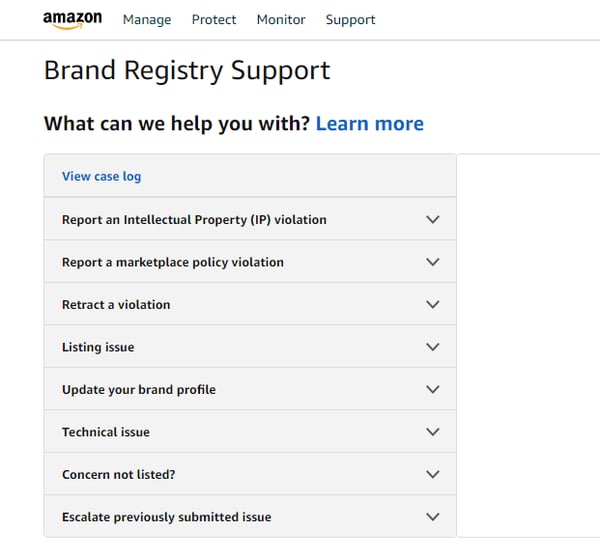
Above: Screenshot of Brand Registry Support from brandregistry.amazon.com
3. Use the search functionality tools in BR and Project Zero
At Bobsled, we often encounter trademark violations by chance. As a general rule, from there we always use the search functionality tools in BR and Project Zero to ascertain whether the violation is a one-off or evidence of a larger problem.
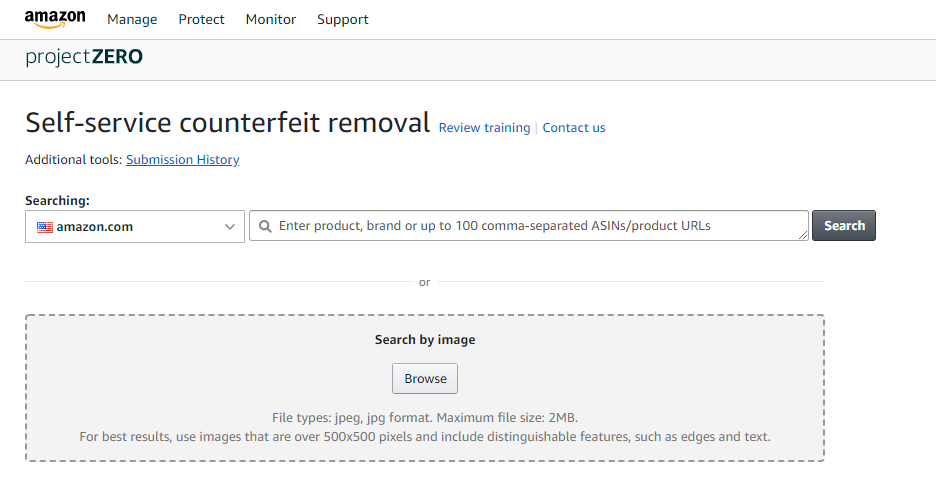
Above: Screenshot of Self-service counterfeit removal from brandregistry.amazon.com
4. Don’t use BR and Project Zero to report unauthorized resellers
Although BR and Project Zero can help remove counterfeit offers from product listings, sellers must not abuse the tool to report genuine offers from other sellers just because the reseller is unathorized to sell on Amazon. Amazon expects sellers and manufacturers to settle these types of disputes outside of their platform. Abusing the tool may result in Amazon removing Project Zero privileges from the brand.
5. Do a test buy to verify product authenticity
Amazon does not appreciate inaccurate violation reports, and having more evidence at your disposal is always a good thing, so placing a test buy to verify product authenticity is often a good idea.
6. Submit a retraction if a violation has been reported by mistake
On a similar theme, if you do accidentally pursue an invalid violation be sure to submit a retraction. A poor infringement reporting success % may scupper your chances at being accepted into programs like Project Zero.
7. Use the escalation option when Amazon is taking too long
to review your case
The longer a counterfeit offer is live the longer it has the ability to damage your revenue and brand integrity - find a solution quicker by escalating the case.
How Much Do You Value Brand Integrity?
Revenue is fantastic, but not when it comes at the expense of brand integrity. As traffic on Amazon grows, the stakes get higher for brands in terms of managing and protecting their trademarked assets.
Are you in need of assistance determining how to include Project Zero or Brand Registry in your overall brand protection strategy? If so, please get in touch with the Bobsled team by completing the form below.
Tagged: Seller & Vendor Central, Brand Protection & Customer Service, Amazon Updates
.png)

